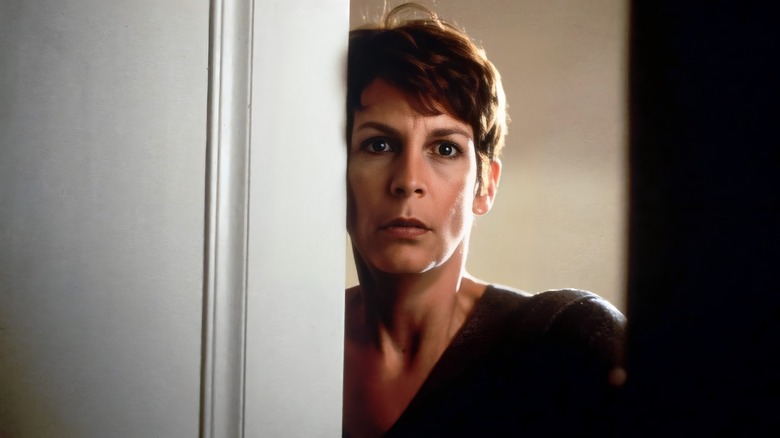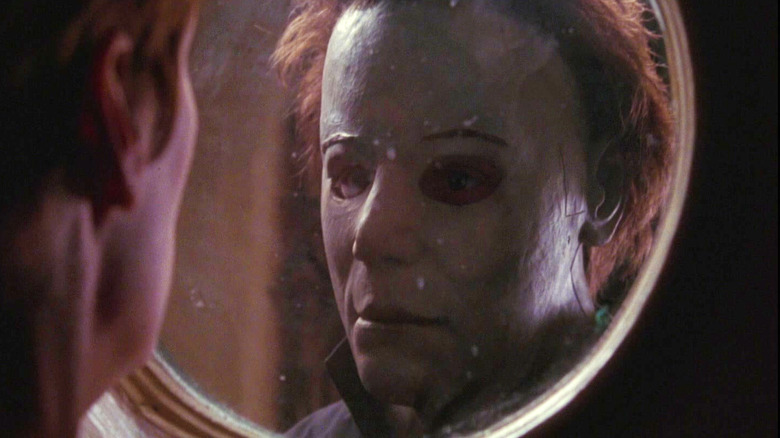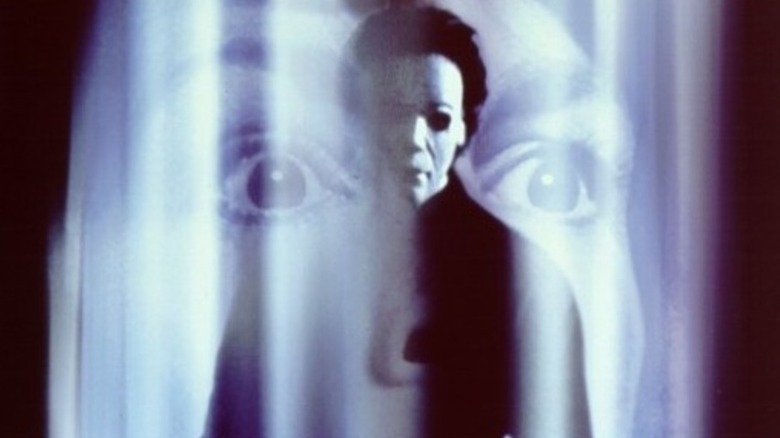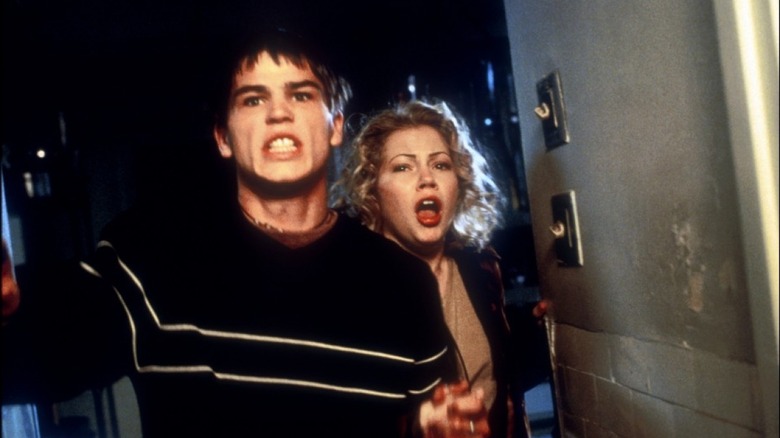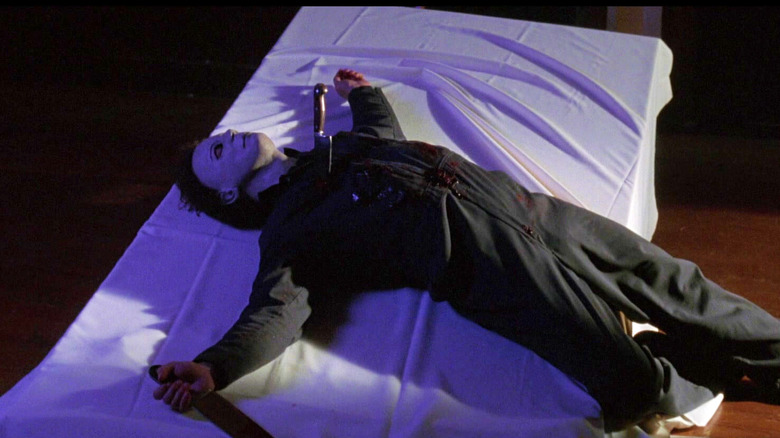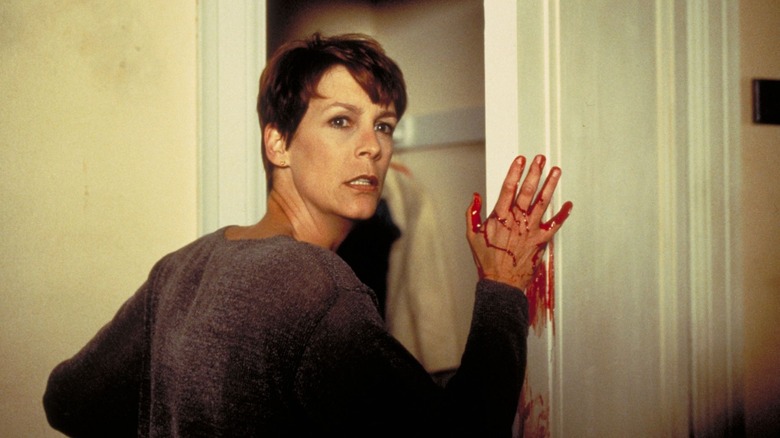25 Years Ago, Halloween H20 Proved Legacy Sequels Could Kill At The Box Office
(Welcome to Tales from the Box Office, our column that examines box office miracles, disasters, and everything in between, as well as what we can learn from them.)
In no small part thanks to the success of 2018's "Halloween," which raked in a ridiculously great $255 million worldwide against a mere $10 million production budget, so-called legacy sequels have become all the rage in the horror genre. Basically, you make a sequel that can serve as both a fresh entry point for new viewers while bringing back some familiar elements to anchor it to the nostalgia train as well. You could certainly look to movies like "Star Wars: The Force Awakens" and "Ghostbusters: Afterlife" as part of this trend as well, but horror truly has been making the most of it in recent years. But, a full 25 years ago, "Halloween" attempted to be well ahead of the curve in this department.
The film in question saw Jamie Lee Curtis reprising her role as Laurie Strode for the first time in 17 years, which was a huge deal at the time. It also introduced new characters in a new setting to help get old fans interested while not alienating younger viewers. It's a strategy that worked damn well, and one that Hollywood would go on to replicate many times in the years to come, although it would be unfair to say that this movie perfected the model as the movie itself — not to mention what followed — is anything but perfect.
In this edition of Tales From the Box Office, in honor of the movie's 25th anniversary, we're looking back at "Halloween H20," how it came to be through a messy development process, how Curtis essentially willed it into existence, what happened when it hit theaters, and what lessons we can learn from it all these years later. Let's dig in, shall we?
The movie: Halloween H20: 20 Years Later
Before diving into the movie itself, it's very important to recount where the franchise was when this movie came out. After trying to turn "Halloween" into an anthology series with "Season of the Witch" in 1982, the producers reversed course with "Halloween 4: The Return of Michael Myers" in 1988. That began a strange trilogy that included 1989's "The Revenge of Michael Myers" and 1995's absolutely bonkers "The Curse of Michael Myers." All of those movies made significantly less than $20 million at the box office, leaving the series on uncertain ground.
Luckily for Miramax and the money men, Jamie Lee Curtis had the idea to celebrate the 20th anniversary of the original "Halloween" with a brand new movie that would see Laurie Strode return. Originally, as explained in the "H20" commentary track, Curtis pitched the idea to John Carpenter and producer Debra Hill, which would have been a true return to form for the series. Unfortunately, Carpenter dropped out of the director's chair in short order, and Hill soon followed. That just left Curtis, which is surely not what she had in mind. Curtis also explained her original pitch:
"My thought from the beginning was this poor girl has been terrorized for 20 years, she's been on the run, her life has been ruined by the trauma she's suffered, and let's meet someone in that shape."
That may sound familiar to anyone who saw 2018's "Halloween," as they're certainly both meditations on what happens to a person in the aftermath of trauma — albeit with radically different results in terms of the film itself. In any event, bringing Curtis back 20 years later was the spark this series needed to help win back viewers who had long since stopped caring, even if it would be without Carpenter and Hill.
The return of Laurie Strode
Jamie Lee Curtis coming back was all good and well, but the continuity of the series had gotten a little wonky at this point. Laurie Strode died off-screen in "Halloween 4," making it tricky to approach what would ultimately become "Halloween H20." There were other ideas for a seventh film in the series, including one titled "The Revenge of Laurie Strode" that, as the title implies, would have been a radically different approach. In the end, what we get is more or less a direct sequel to the first two films that doesn't get bogged down by what came after.
While the final screenplay is credited to Robert Zapia and Matt Greenberg, it was actually Kevin Williamson, coming hot off the success of "Scream," the movie that helped revive the slasher flick in the mainstream, that cooked up the initial story. Williamson would ultimately be credited as an executive producer, but he also did a fair amount of uncredited writing.
"I really wanted to do it," Williamson said to the LA Times ahead of the movie's release. "'Halloween' is my favorite movie of all time. 'Scream' was a love letter to the entire movie — a homage, a tribute. And this ['H20'] is a total celebration of the original. I connected 'Halloween' to 'Scream' to 'Halloween: H20.' It's like a mirror looking into a mirror."
Steve Miner ("Friday the 13th: Part 2") ended up in the director's chair, filling in for John Carpenter. The film he ended up directing centers on Laurie, now the headmistress of a private school, who is still struggling with the now-20-year-old memories of her fateful night with Michael Myers. After faking her death, she believes she's in the clear. But surprise! Michael reappears seeking vengeance and the students, as well as Laurie's son John (played by Josh Hartnett in his feature debut), are in his crosshairs.
The financial journey
Somewhat peculiarly, Miramax decided to release "Halloween H20" late in the summer season on August 5, 1998, as opposed to during the actual Halloween season in October. Instead, "Bride of Chucky" and, interestingly enough, John Carpenter's "Vampires" would enjoy the spoils that October had to offer that year. In any event, audiences were quite happy to embrace a return to this franchise's roots, even if the release date seemed less than optimal on paper.
"H20" placed third on the charts in its opening weekend with a $16.2 million haul, coming in behind Nicolas Cage's "Snake Eyes" and Steven Spielberg's "Saving Private Ryan" in its third weekend. Even against a relatively high (for this series) $17 million production budget, that was a damn good start. For context, "The Curse of Michael Myers" made just $15.1 million domestically during its entire run. Safe to say, the whole "bring back a familiar face after many years" strategy worked like gangbusters.
The film finished its run with $55 million domestically, which was a great result for a franchise that had all but run out of gas just a few years earlier. International figures are hard to come by, but Wikipedia cites an old issue of Variety that indicates that "H20" made $20 million internationally, which gives the movie a $75 million global finish. Adjusting for inflation, that would be around $140 million in today's dollars, give or take. Assuming those overseas figures are even close to correct, that made it the biggest entry in the series up to that point, overtaking 1978's "Halloween" ($70 million).
Success of that magnitude means only one thing when it comes to cinematic horror. Yes, the producers wanted to and ultimately would make a sequel. Unfortunately for Jamie Lee Curtis, that rubbed up pretty hard against what she had in mind, but that's the nature of the beast.
Michael Myers can't die
The problem is that Jamie Lee Curtis always envisioned "H20" as a way to truly bring about closure to the saga of Laurie Strode and Michael Myers. Unfortunately, producer Moustapha Akkad had other ideas. As explained by Syfy Wire in 2022, there was a stipulation in the contract that made it so Michael Myers couldn't actually die. As fans know now, when Michael gets his head chopped off at the end of "H20," it's actually a paramedic that the slasher switched clothes with, allowing for 2002's "Halloween: Resurrection" to happen.
Curtis got close to bailing on "H20" altogether over this situation. "Now, this is a train that's going, I mean we're ready to go. I said, 'I'm not going to do it, I'm not going to tease the audience again. I came up with an idea to end it. I said I won't do it." Ultimately, Williamson figured out a way to kind of make everyone happy with the whole paramedic switcheroo. None of this is explained in "H20," so that movie seems definitive. It's in "Resurrection" where things get silly. Curtis further elaborated:
"I said, 'Okay if you're going to do that and it looks like Laurie has ended it and my audience feels like it's ended, Okay I'll do it. But, you have to pay me a lot of money in the next movie and you have to kill me in the first 10 minutes of the movie because I've now killed an innocent man and I can't live with that.'"
And so, that's how it went. Laurie was killed off in the opening minutes of "Resurrection," and new characters, instead, face off against Michael Myers. This includes, rather famously, Busta Rhymes doing kung-fu during the film's climax. It was a big step down from "H20" and paved the way for Rob Zombie's divisive reboot in 2007.
The lessons contained within
It wouldn't quite be fair to say that "H20" is the first legacy sequel, as movies like Martin Scorsese's "The Color of Money" — a years-later sequel to "The Hustler" — did it first. But this is the movie that laid out the true template for what other franchises would do years later to great success. "Star Wars: The Force Awakens" made more than $2 billion at the global box office largely employing this model. "Jurassic World" is an arguably purer example of the legacy sequel concept firing on all cylinders, with the film earning a staggering $1.67 billion. Again, 2018's "Halloween" was also a stupefyingly impressive deployment of this concept.
It's become a familiar formula but one that didn't catch on for some years after this movie came out. For that reason, it feels like "H20" maybe doesn't get the credit it deserves — even if the Michael Myers mask in the movie is unforgivably bad. But that's another conversation entirely. Maybe it has something to do with the fact that this same franchise did the legacy sequel thing but did it better another 20 years later. Funny how these things come back around.
The thing that maybe sticks out most about "H20" is how it felt like wringing blood from a stone after the fact. Jamie Lee Curtis had the right idea in trying to provide audiences with true closure. Yet, commercial realities prevented that from happening, and "Resurrection" cheapened what this movie accomplished. For as much as certain folks may not dig Rob Zombie's "Halloween" films, he tried to do something different, particularly in "Halloween II," and moved away from what came before. There's something to be said for that.
Mainly, it feels like "H20" is owed some credit in the annals of cinema history for laying out a business model that has become wildly successful. Sure, maybe this legacy sequel thing makes certain viewers roll their eyes, but it works time and time again. Credit where credit is due, this movie was well ahead of the curve.
